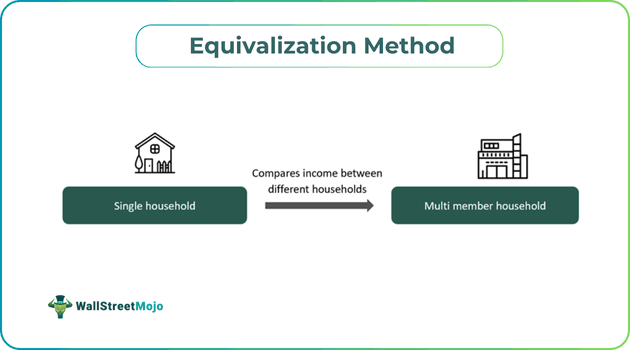Table of Contents
Equivalisation Definition
Equalization is the practice of modifying income statistics to allow for more insightful comparisons of incomes among households of various sizes and compositions. This is called equivalized income. It is employed in the estimation of indicators of poverty and social exclusion.

This variable reflects the fact that, in general, a larger household would require more money than a smaller one to maintain the same living level. The modified OECD equivalency scale is employed to estimate it. In addition, a standardized household's economic resources can be estimated from the equivalised total household income.
Key Takeaways
- Equalization is a methodology that modifies household income to consider several household types' various financial resource needs.
- Equivalent total household income can be used as a measure of the financial resources available to a standardized household. It can also be viewed as an indicator of how much economic resource is available to each household member.
- Equivalence scales give each household category in the population a value corresponding to its demands.
- The size of the considered household and the ages of its members (whether they are adults or children) are the main considerations for allocating these values.
Equivalisation in Accounting Explained
Equivalization is a methodology that modifies household income to consider several household types' various financial resource needs. A representative income is then produced by dividing the total household income by the sum of the weightings. Total household income on equivalization is zero when total household income is negative. It is treated the same when losses from an unincorporated business or other investments outweigh any positive income from any other source.
Equivalent total household income can be used as a measure of the financial resources available to a standardized household. It corresponds to the household income for a one-person household. It measures how much money a household with several people would need to make to have the same financial or economic well-being level as a household with only one person.
It can also be viewed as an indicator of how much economic resource is available to each household member. Thus, to determine the mean equivalised household income, the equivalised total income of all households is added, and the result is divided by the population. This enables those who live in large households to contribute to the median on par with those who live alone.
Equalization or equalization in accounting and taxation is the process of adjusting a taxing district's assessed property values to align with assessment values in neighboring taxing districts.
Scales
Equivalence scales give each household category in the population a value corresponding to its demands. The value distributed is often needs such as electricity, space, water etc. The size of the considered household and the ages of its members (whether they are adults or children) are the main considerations for allocating these values.
A certain equivalence scale is selected based on technical assumptions about consumption economies of scale. The value assessments about the relative importance of different people's needs, such as those of young children or older people, are also considered. These are crucial as the conclusions will influence the outcome.
Equivalence scales consider various characteristics of household composition. The simplest scale is the "square root" scale. This scale utilizes the weight as the square root of the household size. The second scale of OECD's equivalence scale gives a value of one to the first household member, 0.7 to every additional adult counted, and 0.5 to each child. It is otherwise known as the Oxford scale. Another scale that the OECD uses is the modified scale, which assigns a value of 1 to the head of the household, 0.5 for additional members, and 0.3 for the children.
Similarly, other scales, such as the Joseph Rowntree Foundation's "Minimum Income Standard," or MIS, and the "Three Parameter Scale" used for the Supplemental Poverty Measure by the US, give single-parent households a different weighting.
Examples
Check out these examples for a better idea:
Example #1
Suppose XYZ institution wants to collect data to analyze household income for a small locality. It wants to assess the poverty rates prevailing in that particular population and uses an OECD-modified scale. The results here would not paint an appropriate picture, as they would show a high poverty rate among children. This is because children's collective weight may outweigh adults' weight, especially if they are fewer in number. Hence, picking a measure that gives greater weight to each additional member is to be avoided.
Example #2
Below is a table demonstrating the estimation of the equivalisation process using the OECD's modified scale.
| Household composition | Equivalising factor ( x) | Disposable income in $ (y) | Equivalised disposable income (y/x) in $ |
|---|---|---|---|
| Single person | 1.0 | 1000 | 1000 |
| Two persons (adults) | 1.5(1+0.5) | 1500 | 1000 |
| Three persons(adults) | 2(1+0.5+0.5) | 2000 | 1000 |
| Two persons with a child | 1.8(1+0.5+0.3) | 1800 | 1000 |
According to the OECD's modified scales, one adult member is given a value of 1, and every additional member is given a value of 0.5. If there are three adult members, the total value would be 1+ 0.5 for the first person and 0.5 for the second person, and hence, it would total a value of 2. Similarly, a value of 0.3 is taken for a child. In this case, a three-member family with a full-grown adult will require a household income of $2000 to live a similar lifestyle as a single person with an income of $1000.
